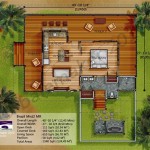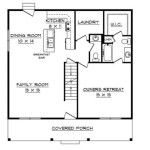Design Your Dream Home: Small House Plans for Compact Living
The rising cost of land and the increasing desire for sustainable living have fueled the popularity of small house plans. Compact living necessitates thoughtful design and meticulous space utilization. This article provides guidelines and considerations for designing a dream home within the constraints of a small footprint, focusing specifically on achieving a functional and aesthetically pleasing living room.
Small house plans are characterized by efficiency and adaptability. They prioritize multi-functional spaces and clever storage solutions to maximize every square inch. The living room, often the heart of the home, requires particular attention in small house designs. It must serve as a place for relaxation, entertainment, and potentially even work, all within a limited area. Careful planning ensures that small living rooms feel spacious, comfortable, and not cramped.
The key to successful small house design lies in understanding the principles of space planning, furniture selection, and visual enhancement. These elements work in concert to create a living environment that caters to the needs of the occupants without sacrificing style or functionality.
Prioritizing Space Planning and Functionality
Space planning is the foundation of any successful small house design, and the living room is no exception. Before considering furniture or decor, it is essential to understand the intended use of the space and the flow of movement within it. Start by determining the primary activities that will take place in the living room. Will it primarily be used for relaxation and watching television, or will it also serve as a space for entertaining guests or engaging in hobbies? The answers to these questions will dictate the layout and furniture requirements.
Consider the natural light sources within the room. Windows and skylights should be strategically placed to maximize natural illumination and create a sense of openness. Avoid obstructing windows with bulky furniture or heavy curtains. Instead, opt for lightweight window treatments that allow light to filter through while maintaining privacy.
The flow of traffic is another crucial aspect of space planning. Ensure that there are clear pathways connecting the living room to other areas of the house, such as the kitchen, dining room, and bedrooms. Avoid placing furniture in a way that obstructs these pathways or creates bottlenecks. A well-planned layout allows for easy movement and prevents the feeling of being confined.
Multi-functional furniture is essential in small living rooms. Consider pieces that can serve multiple purposes, such as a sofa bed for accommodating guests or a coffee table with built-in storage. Ottomans with removable tops can provide additional seating and storage space. By selecting furniture that is both functional and versatile, you can maximize the use of available space.
Vertical space is often overlooked in small house designs. Utilize wall-mounted shelves and cabinets to store books, decorations, and other items. Shelves can also be used to display plants or artwork, adding visual interest to the room. Consider installing a tall bookcase or a ladder to access higher shelves, maximizing storage capacity without taking up valuable floor space.
Open floor plans can significantly enhance the sense of spaciousness in small houses. By combining the living room with the kitchen or dining area, you can create a larger, more open living space. This eliminates the need for walls and partitions, allowing light to flow freely throughout the area. When designing an open floor plan, it is important to define distinct zones for each activity. This can be achieved through the use of area rugs, furniture placement, or changes in flooring material.
Strategic Furniture Selection and Placement
Choosing the right furniture is critical for maximizing space and comfort in a small living room. Scale is paramount; oversized furniture can quickly overwhelm a small space, making it feel cramped and cluttered. Opt for smaller, more streamlined pieces that are proportionate to the room's dimensions.
Consider using modular furniture, which can be easily reconfigured to suit different needs. Modular sofas and sectionals can be arranged in various configurations to create different seating arrangements. This flexibility allows you to adapt the living room to accommodate different activities, such as hosting a party or relaxing with family.
Lightweight furniture is easier to move and rearrange, providing greater flexibility in a small space. Choose chairs and tables made from lightweight materials such as rattan, bamboo, or metal. These materials are not only lightweight but also durable and stylish.
Clear furniture, such as glass or acrylic tables and chairs, can create a sense of openness and lightness in a small living room. These materials allow light to pass through, making the room feel less cluttered. Consider using a glass coffee table or acrylic chairs to create a more spacious and airy feel.
Floating furniture, such as wall-mounted shelves and consoles, can free up floor space and create a sense of lightness. These pieces appear to float above the floor, making the room feel more open and spacious. Consider mounting your television on the wall to eliminate the need for a bulky entertainment center.
When arranging furniture in a small living room, avoid blocking pathways or creating obstacles. Leave ample space between furniture pieces to allow for easy movement. Consider creating a focal point in the room, such as a fireplace or a large piece of artwork, and arrange the furniture around it. This helps to create a sense of balance and harmony in the space.
Rugs can define spaces and add warmth to the room. Choose a rug that is proportionate to the size of the living room. Larger rugs can make the room feel more spacious, while smaller rugs can define specific seating areas. Be sure to leave some exposed flooring around the perimeter of the rug to prevent the room from feeling too crowded.
Visual Enhancement and Design Tricks
Visual tricks can significantly enhance the perception of space in a small living room. Color, lighting, and mirrors are powerful tools for creating the illusion of spaciousness.
Light colors reflect light, making a room feel larger and brighter. Paint the walls in light, neutral colors such as white, cream, or light gray. These colors create a sense of openness and airiness. Avoid using dark colors, which can make a small room feel even smaller and more cramped.
Strategic lighting can dramatically alter the perception of space in a small living room. Layered lighting, which combines ambient, task, and accent lighting, can create depth and dimension. Use recessed lighting or track lighting to provide ambient illumination. Add task lighting, such as table lamps or floor lamps, for reading or other activities. Use accent lighting to highlight artwork or architectural features.
Mirrors are a classic trick for creating the illusion of space. Place a large mirror on a wall to reflect light and create the impression of a larger room. Mirrors can also be used to reflect views from windows, bringing the outdoors in and creating a sense of connection to nature.
Vertical stripes can visually elongate a room, making it appear taller. Consider using wallpaper with vertical stripes or painting vertical stripes on an accent wall. This trick can be particularly effective in rooms with low ceilings.
Minimize clutter to create a sense of spaciousness. Clutter can make a small room feel even smaller and more cramped. Store items out of sight in cabinets, drawers, or storage containers. Regularly declutter the living room to keep it looking tidy and organized. Consider creating a designated storage area for toys, books, and other items.
Incorporate natural elements, such as plants and natural light, to create a sense of connection to the outdoors. Plants can add life and color to a small living room, while natural light can make the room feel brighter and more inviting. Consider placing potted plants near windows or hanging plants from the ceiling. Open the curtains or blinds during the day to allow natural light to flood the room.
Use a cohesive color palette to create a sense of harmony and balance in the living room. Choose a limited number of colors and use them throughout the space. This helps to create a sense of unity and prevents the room from feeling too busy or cluttered.
Small house plans for compact living rooms require careful consideration of space planning, furniture selection, and visual enhancement. By prioritizing functionality, utilizing multi-functional furniture, and employing clever design tricks, homeowners can create living spaces that are both comfortable and aesthetically pleasing within the confines of a smaller footprint.

Small House Plans Simple Tiny Floor Monster

Best House Plans Floor 2025 Dream Home

4 Need To Know Tips For Decorating A Small Space

Small House Plans Designed For Compact Living

Cozy Santa Barbara Tiny

10 Small House Plans With Open Floor Blog Homeplans Com

59 Small Living Room Ideas For 2025

Small To Build Open Floor Plans Blog Eplans Com

Stylish And Simple Inexpensive House Plans To Build Houseplans Blog Com

Small House Plans Designed For Compact Living
Related Posts








